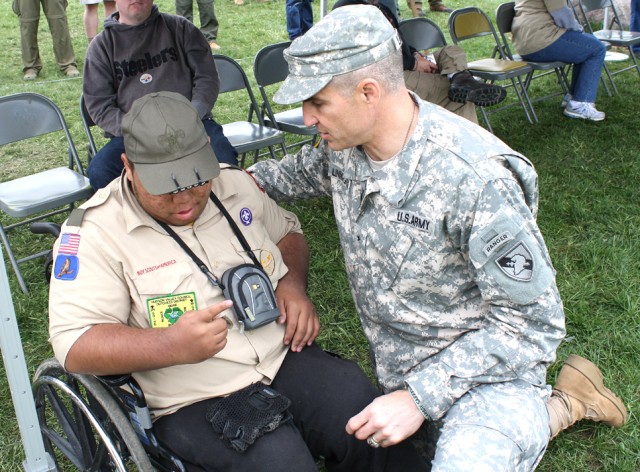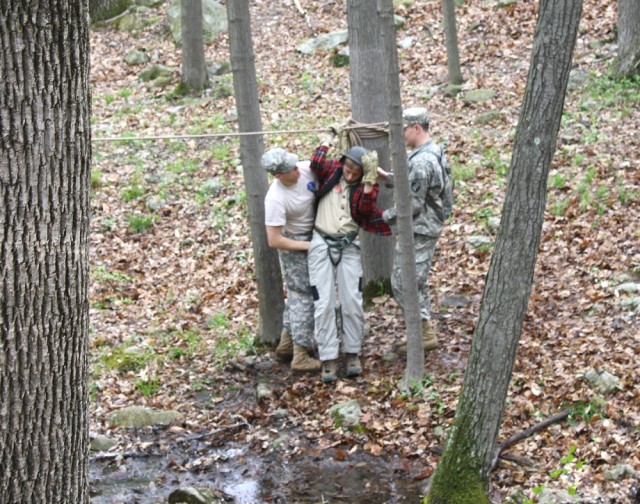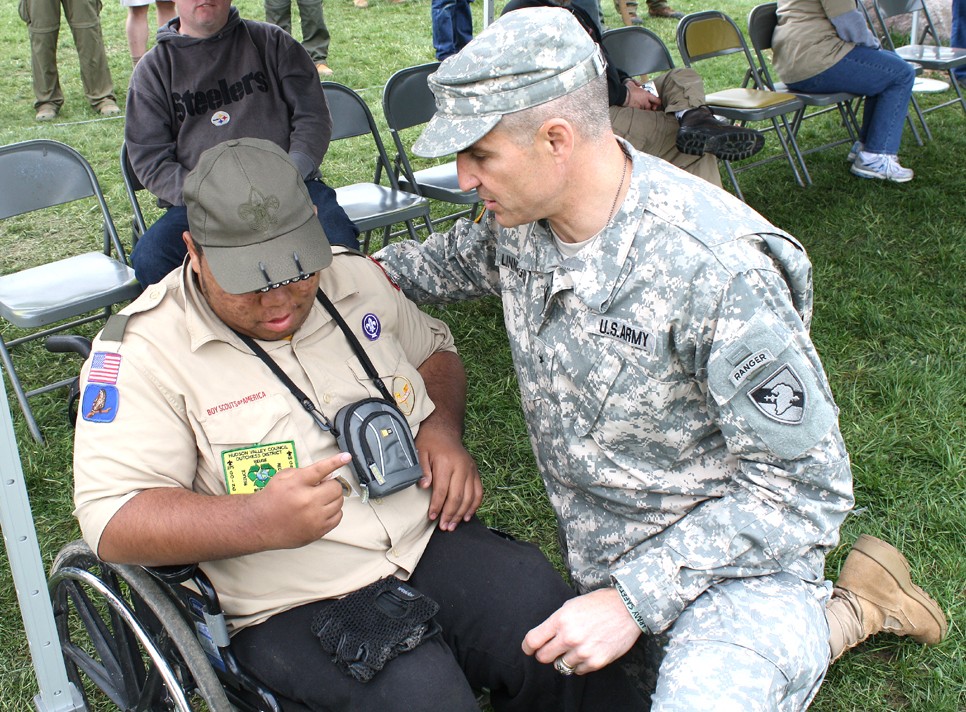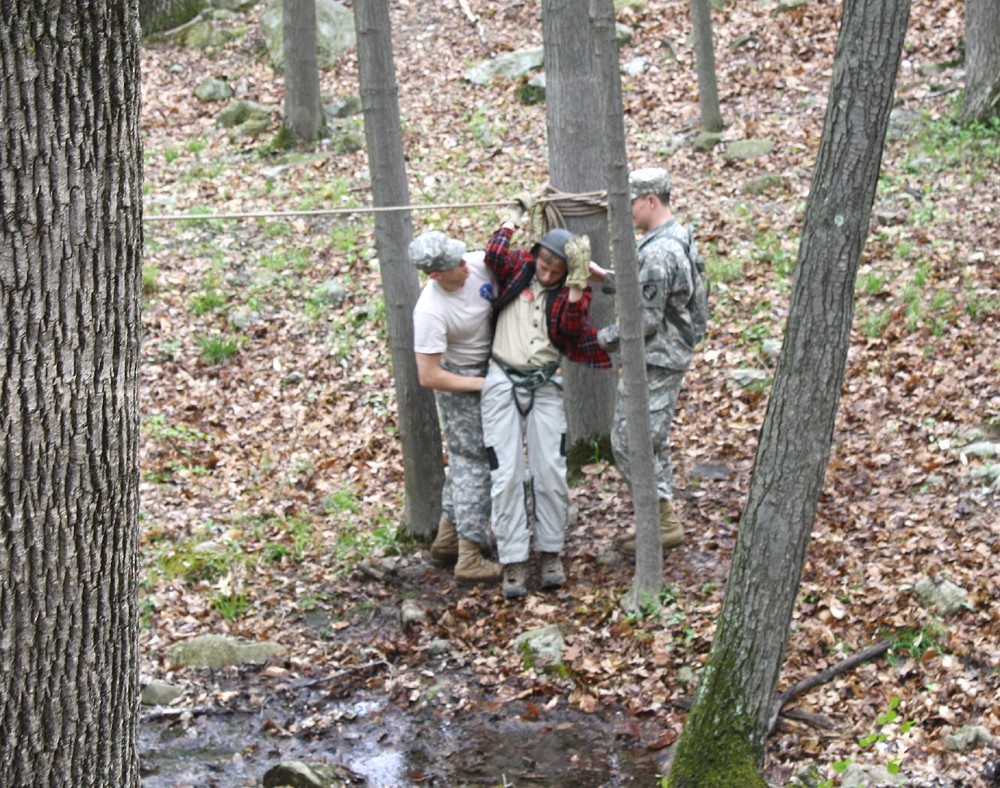The 47th West Point Camporee brought 141 Boy, Girl and Venture Scout troops--about 3,200 people, to Lake Frederick May 1-3 for the most selective scouting event in the nation. Scout troops came from the tri-state area from as far away as Virginia, Michigan, Ohio and California.
There were more than 280 Girl Scout, Boy Scout, and Venture troops who applied to the 2009 Camporee but fewer than half are accepted every year.
Cow Brad Davis, Scout Council S-1, manages the selection process for the various application categories, including troop size and whether they intend to drive or backpack over Bull Pond Hill to the campsite.
"The Scoutmaster's Council strives to keep variety in the camporee by inviting different types of troops and by picking troops from across the country. It is as much about coming to West Point as it is about meeting other junior leaders from across the nation," Davis said.
Lt. Col. John Graham, Council officer representative, said, "these scouting organizations and the U.S. Military Academy share many of the same ideals of leader and character development. This is evident in each incoming USMA class--between 30-40 percent of the new cadet classes are Boy and Girl Scout participants. The Camporee also serves as a leadership laboratory for the cadets. You can imagine the coordination required to organize a three-day event on the open fields of MWR's Lake Frederick complex."
This year's camporee focused on leadership. Firstie Matthew Schlesinger, cadet-in-charge of the Council, said "I challenged every scout troop to rise to the scout motto and complete their goals. To help them meet the challenge, I assigned one cadet as a mentor to every scout troop."
For the visiting scout troops, the camporee is a test of junior leadership. oints were awarded in different categories including the grenade toss, fire starting, Swiss seat making, orienteering, knot tying, camouflage, wilderness survival and spirit. This year, the Top 3 finishers included a Venture, a Girl Scout and a Boy Scout troop.
Schlesinger also focused on cadet leadership development. Only two other firsties on his primary staff, Derek Brown and Brian Kent. The rest of the staff were cows, yearlings and even a plebe.
"We used this camporee to develop next year's club leadership. A few new innovations in parking and inprocessing worked great with this junior team," Brown said.
Since inception, the camporee has been a celebration of the ties between cadets and their scout troops. Cadet sponsorship is the most heavily weighted criteria in the invitation list.
About 100 of this year's troops have a direct relationship a cadet. The cadet sponsors give their time planning and executing the camporee as an opportunity to thank the scout troop that nurtured and developed their desire to serve this country and live the scouting life.
This year's bonfire was the biggest ever. After lighting the huge woodpile, the evening was topped with talent shows, skits and music that carried across Central Valley. One scoutmaster commented, "This show is awesome. I don't think many people understand how 'cool' scouting really is."
The most impressive of the troops are called Lightfighters. This year, more than 30 troops took the challenge. While other troops back their vehicles up to their campsite and deposit tents and sleeping bags, the Lightfighters take the hard way. They leave their vehicles behind at Camp Natural Bridge and hike the backwoods to Lake Frederick, including the infamous Bull Pond Hill.
These troops are rewarded upon arrival with a special tab to be worn above the camporee patch on their uniforms and bragging rights.
Brigadier Gen. Minchael Linnington, Commandant of Cadets, presided over the closing ceremony and parade. Linnington, a West Point Camporee veteran, came with bags of Army uniform pins to trade with the visiting scouts.
After one trade of push ups for an eagle (colonel rank), the scout asked, "Are these as good as a yellow cadet brass' I was kind of hoping for one of those."
In reviewing the activities of the weekend, Linnington commented on how well-organized everything was.
"I am so impressed with this cadet-run event. Every comment from the visiting scouts is a testament to our cadets and their leadership," Linnington said.
The camporee depends upon a great deal of support from across West Point. The Garrison provides the use of the campsite, expertise and supporting materials.
"This is the first year that the camporee was entirely coordinated by staff. The garrison leaders worked directly with my team of fellow cadets instead of going through the club OIC. We learned a lot that will pay off when we are platoon leaders," Kent said.
In fact, the Scoutmaster's Club is actually too small to run the entire event.
"We depend on other cadet clubs (to) provide demonstrations to include sky diving, weapons displays, rope bridges, radio operations, music and first aid," Yearling Cliff Lutz, Camporee operations officer said.
Without the whole USMA team the camporee would just be a bonfire by a lake.




Social Sharing